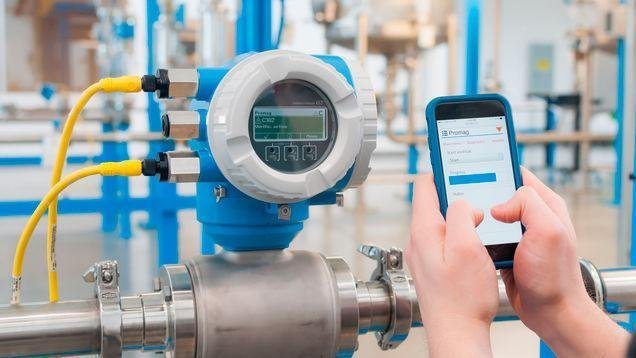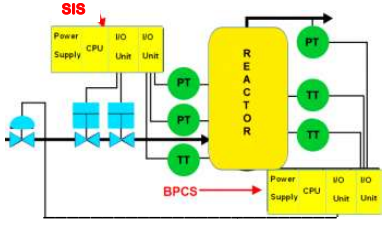

Introduction
What is a SIS?
A Safety Instrumented System (SIS) is a system which takes automated action to keep a plant or process in a safe state when abnormal conditions occur.
They are often a complex configuration of electrical, electronic and/or programmable electronic devices such as sensors, computer-controller and final control elements installed in a plant to provide an independent system of protection at a particular level of integrity against a hazard which may arise in the plant or process.
There is a functional safety standard which covers the general aspects of SISs; IEC 61508 “Functional Safety of Electrical/Electronic/Programmable Electronic Safety-related Systems”. There is also a standard specific to process industries; IEC 61511 “Functional safety – Safety instrumented systems for the process industry sector”.
What is a SIF?
A Safety Instrumented Function (SIF) is a single safety loop within a SIS. SIFs can vary in complexity, and so may consist of:
- a single limit switch, a relay and a valve, or
- multiple sensors with particular voting configurations hard wired, comm’s connected and/or wirelessly connected to a multiple input/output logic solver with advanced computing power and Human Machine Interface (HMI) which will operate a number of final control elements such as valves and/or power contactors.
The SIF forms part of the risk prevention layers of protection in the overall safety system.
Who needs SIS training?
This course is aimed at those who have responsibilities within the scope of IEC 61508 and IEC 61511 in particular or those aspiring to implement same in the future.
Plant managers of process plants who have responsibility for the management of functional safety involving Safety Instrumented Systems.
Control and instrumentation engineers, chemical engineers, mechanical engineers, electrical engineers, electrical technicians and senior electricians who have responsibility for HAZOPs and SIL determination exercises, specification, design, operation and maintenance of plants employing Safety Instrumented Systems.
Systems integrators, of Safety Instrumented Systems, designing systems to meet the requirements of IEC 61511.
End users’ who wish to have a better understanding of the design and systems integration process so they are able to make informed decisions that have an impact the operation and maintenance phase (e.g. implications on future maintainability of the Safety Instrumented Systems).
What are the advantages to the plant employees?
The better the understanding of Functional Safety by the greater number of employees is the safer the plant is going to be as a place of work.
The better the understanding of Functional Safety by diverse disciplines is the more understanding and cohesion that will exist among the overall group as a whole and the individual roles that need to be carried out.
Structured and systematic work practices have to be adopted where all record keeping and documentation is rigidly adhered to and individual duties and responsibilities of all are clearly identified.
Staying abreast with modern technology is essential for all present day practicing professionals.
What are the advantages to the plant owners?
Disasters, such as explosions, are likely to cause fatalities, severe injuries, minor injuries which result in human grief and suffering and huge financial losses through litigation and compensation.
Great financial losses can be incurred due to damage to plant equipment, product, the environment and the company’s international reputation.
The most recent publication of IEC 61511 in 2016 specifies a list of items to consider when evaluating the competency of persons involved in the process safety life cycle activities.
Frequent testing, monitoring and verification of systems will significantly reduce the amount of down time at the plant and increase profits.
Large global multinational plants will now have the same set of Safety Standards in all plants worldwide so the information and data collected on devices and equipment will apply to all which will greatly increase overall safety.
What evidence of participation is given?
A Certificate of Attendance will be presented to each attendee outlining the Module covered and the topics therein.
Layers of Protection

Safety Instrumented Function

Process Functional Safety Training [Module 1]
Safety Instrumented Systems

[1] Introduction to Process Operation and Performance; Measurement, Automation, Control Systems, Human Interface and Networks, Process Safety Protection System, Equipment Under Control [EUC]. Sensors, Logic Solvers and Final Control Elements.
[2] Hazards and Risks; Inherent Risk and Tolerable Risk. Typically acceptable risk values. Standards, Rules and Regulations. The role of IEC 61508 and IEC 61511.
[3] Risk Reduction Techniques; Independent Layers of Protection using alternative methods such as mechanical and electrical devices.
[4] The Safety Life Cycle; The concept of Safety Management by implementation of a defined set of procedures. Analysis of the Safety Life Cycle’s individual steps in the flowchart.
[5] Safety Instrumented Systems; The configuration of Electrical, Electronic and Programmable Electronic Systems to provide a defined level of protection. Low Demand, High Demand and Continuous Demand Mode. Safety Integrity Levels, Fail Safe and Reserve Energy, Safety Instrumented Function.
[6] System Failures; Random Failures, Common Cause Failures, Systematic Failures.
[7] Mathematical Constants for each SIL approved device; Reliability, Un-reliability, Failure Rates, Bath tub Curve, Exponential Relationship with Time, Availability, Safe Failure Fraction, % Safe, Risk Reduction Factor, Mean tine to Failure, Mean Repair Time, Mean Down Time, Probability of Failure on Demand, Probability of Failure per Hour,
[8] Device Types and Configurations: Type A and Type B devices, Hardware Fault Tolerance, Typical Voting Configurations, Triple Modular Redundancy, Achieving SIL1, SIL2 and SIL3 levels of protection,
[9] Low Demand Mode Calculations; Equations for calculating Probability of Failure on Demand, Equations for Spurious Trip Rates, Calculations with single input and single output circuits using typical industrial devices.
Learning Outcomes [Module 1]
On successful completion of this module the learner will be able to:
| LO1 | describe and define automatedprocess operation and performance under normal and abnormal condition where a level of risk may arise |
| LO2 | apply reliability theory to the solution of practical problems involving electrical, electronic and programmable electronic safety devices |
| LO3 | select appropriate electrical and electronic devices based on their characteristics and construct basic safety circuits utilising these components based on IEC 61508 and IEC 61511 standards in low demand mode |
| LO4 | specify and verify basic series safety circuits with single input and single output configuration and verify the SIL level provided in low demand mode using Route 1H |
| LO5 | source device data sheets, certificates of compliance and understand the schematic circuitry involved in constructing the safety loop |
Process Functional Safety Training [Module 2]
Safety Instrumented Systems

Course Details
[1] Diagnostics and Proof Testing; Periodic Interval Testing, On-Line Diagnostics, Partial Stroke Testing, Useful lifetime of devices, Working life of the SIF. [2] Low Demand Mode Calculations; Equations for calculating Probability of Failure on Demand of multiple input multiple output safety instrumented functions, Equations for Spurious Trip Rates. [3] Complete System Design; Safety budget allocation to SIF individual units, Forward and Reverse design approach. Safety budget allocation. [4] Plant Specific Design; Complying with Stage1 and Stage 2 of IEC 61511, Interlocks, Permissive’s, By-Passes, Inhibits and Over-rides. [5] Verification and Validation; Installation, Commissioning and Validation as per Stage 3 of IEC 61511, Testing and Documentation of the safety system in the factory [FAT] and on site [SAT]. [6] Maintenance, Modification and Decommissioning; As per Stage 4 and Stage 5 of IEC 61511.
Learning Outcomes [Module 2]
On successful completion of this module the learner will be able to:
Process Functional Safety Training [Module 3]
Safety Instrumented Systems

Course Details
[1] Continuous Demand Mode Calculations; Equations for calculating Probability of Failure per Hour, Equations for Spurious Trip Rates, Calculations with different Voting Configurations.
[2] Subsystems with diverse components; Calculating Failure Rates and Spurious Trip Rates for SIF’s consisting of diverse devices. Route 1H and Route 2H methods for Architecture compliance, Systematic Failure Capability.
[3] Specification of Sensor, Logic solvers and Final Control Elements; Parameters to be measured such as instantaneous value, average value, rate of change value. Triple modular redundancy, HART protocol, radio link and fibre optic comms. Generic data and Certified data.
[4] Software and System Evaluation; Categories of software programming employed in safety loops. Basic alarm management and control room ergonomics.
[5] Event Tree Analysis; Risk reduction analysis and apportioning of risk reduction values. Practical situation evaluation.
[6] Site Safety Index; Implementation of a simple five-level model to help measure the impact of operations and maintenance processes. Functional Safety Audit versus Functional Safety Assessment.
[7] Practical Case Studies; Analysis of industrial safety instrumented projects designed and installed in a number of different industries.
Learning Outcomes Process Functional Safety Systems [Module 3]
On successful completion of this module the learner will be able to:
| LO1 | specify and verify basic series safety circuits with single input and single output configuration and verify the SIL level provided in continuous demand mode |
| LO2 | calculate the SIL level provided at low demand mode and continuous demand mode by alternative device configurations including diverse components |
| LO3 | specify the correct safety devices for any particular SIF application |
| LO4 | utilize event tree analysis to determine the requires SIL levels required |
| LO5 | evaluate the overall effectiveness of the plant’s safety instrumented functions |
CONTACT DETAILS
Phone: +353 87 2371824
Email: info@btl.ie
Address: Chapel Road,
Ovens, Co Cork. Ireland
P31 K179

